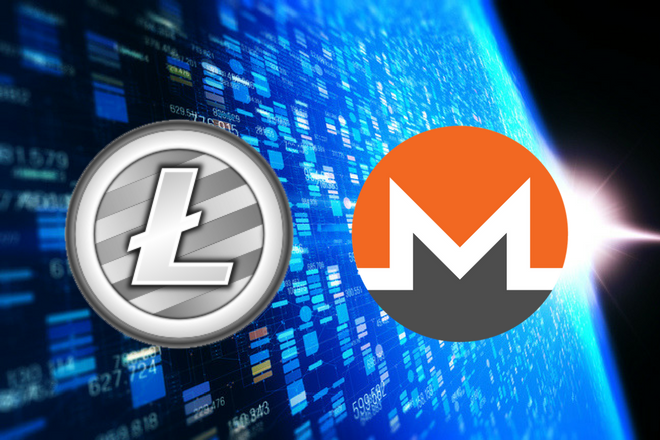Cryptocurrencies like Bitcoin, Ethereum, and Ripple tend to grab most of the headlines. But if recent rumblings are to be believed, two other prominent altcoins may be about to create their own waves.
Litecoin (LTC) is the silver to Bitcoin’s gold and it’s meant to be a functional currency for daily use in the future. Monero (XMR) is arguably the premiere privacy token out there, and it’s meant to afford anonymity and censorship resistance. Back in January, LTC founder Charlie Lee met with Riccardo Spagni, a project leader of XMR. The meeting was followed by a series of tweets that have kicked speculation into high gear.
First, there was this tweet from Spagni (@fluffypony):
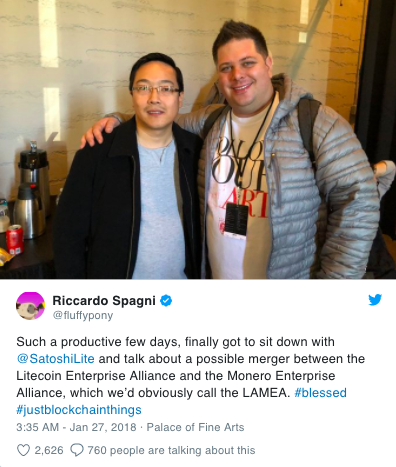
Charlie Lee (@Satoshi Lite) quickly chimed in to point out that Spagni was kidding, but also to approve of the idea of a LTC/XMR collaboration.
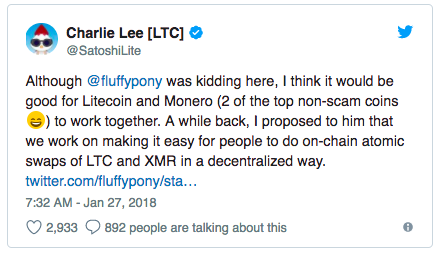
Atomic swaps allow for two different cryptocurrencies to be exchanged, instantly and in a secure manner, across two different blockchains. They essentially cut out the need for exchanges and provide a way to facilitate P2P trades in a completely trustless way.
Segregated Witness (SegWit) was implemented in May 2017, and after this was completed atomic swaps were first tested on the Litecoin network. For those who don’t know, SegWit is a proposed solution to Bitcoin’s scaling problems. In simplified terms, it’s the process by which the block size limit on a blockchain is increased by removing signature data from transactions, freeing up space to add more transactions to the chain.
It factors into this discussion because in order for an atomic swap to occur both SegWit and the lightning network must be operational on two different blockchains. Fast forward to the fall of 2017 and this is exactly what transpired, with the first atomic swap between Litecoin and Bitcoin being successfully completed in an off-chain payment channel. Others have followed suit, and the setting is now truly primed for further development.
Although Spagni’s tweet was clearly a joke, it seems to have struck a real chord. Lee continued:
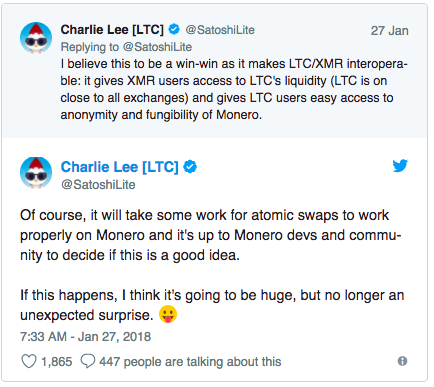
The logic of these tweets is hard to refute. Litecoin is widely used (available on almost all fiat exchanges), and atomic swaps would allow more people to buy XMR via LTC. Conversely, Charlie Lee has expressed an interest in and a desire for greater privacy (precisely like that offered by XMR). Both currencies clearly have a lot to offer each other. More than a few news outlets/blogs took this information, ran with it, and started speculating about a possible merger.
Would a “Merger” Work?
Before things get too carried away, a few clarifications are in order.
If Spagni’s suggestion that the Litecoin Enterprise Alliance would merge with the Monero Enterprise Alliance led you to think this would create a singular entity/token/blockchain, you’d be mistaken. If XMR and LTC were to truly merge, this would require something akin to a reverse fork, which, while not impossible, would likely be very messy.
The primary hurdles in this scenario would be creating new tokens and then figuring out what happens next. This might sound simple, but to ensure that this happens fairly and that the merger is a success, there would likely be a need for centralized control. This could take many forms: who defines the terms, who writes the airdrop software, what any new rules will look like, how the token allocation will be handled – all potentially problematic issues.
Because of Monero’s unique privacy features, things could be especially complicated. Crypto podcaster Mike Croteau poses the question:
“How would a merger between Monero and some other coin work, for instance, if it’s impossible to know who owns what Monero, or how much? That’s not to say there isn’t an answer to that question, but the math becomes quite a lot trickier.”
So if we’re not talking about a merger of blockchains or development foundations, what are we talking about?
What Charlie Lee really indicated in his tweets is making LTC and XMR interoperable through on-chain atomic swaps (as mentioned above) and other collaborations. Interoperable is computer science speak for compatible, or able to work together. More on this below.
Some have dismissed this incident as little more than two guys expressing admiration for each other publicly, or stating that if there ever were a chance to work together they’d be all for it. We could speculate about whether or not this will come to fruition, or we could focus on the more interesting question: should it?
The Pros
- If Litecoin wants to deliver the ability to transact and store money anonymously, then developing partnerships with a currency like Monero is the golden ticket. It would save them tremendous development time (and effort) and allow them the ability to take advantage of Monero’s privacy and security protocols, which are some of the most robust around.
- Litecoin is known as a no-headache coin. It’s one of the most widely available and stable coins on the market, which could prove to be a real boon for a token like Monero that seeks greater liquidity.
- Currently, in order to buy XMR, you first need BTC (it’s the most popular trading pair), and then you need to use an exchange. If BTC continues to have issues with fees and scaling, having the ability to atomic swap with a widely-used lite client could be extremely beneficial for Monero.
- Neither of these coins has the clout of BTC or ETH. By pooling some of their collective forces, it could provide both with bigger profiles and increase their respective values.
- Litecoin founder Charlie Lee sold all of his Litecoin in December, and while he defended this action vigorously, it cost him some political capital. A partnership with another strong cryptocurrency could help shore up any lingering doubts people may have about his commitment to Litecoin.
- A collective agreement between Monero and Litecoin could continue to push the boundaries of what’s possible with atomic swaps, bringing us more quickly to the future where everything is done on-chain.
The Cons
- Question marks remain over whether transferring tokens between Litecoin’s network and XMR could potentially compromise some of the privacy features of Monero – obviously, this would be a huge issue for holders of Monero.
- Developers looking to create atomic swaps between vastly different protocols are faced with significant challenges. It’s unclear exactly how big of an undertaking this is in terms of CryptoNote (Monero’s protocol) and Litecoin’s forked version of Bitcoin Core.
- If a collaboration were established and both coins grew rapidly as a result, this could lead more quickly to a crackdown by authorities, who may be concerned about the use of Monero for illicit activities.
- A cooperation between LTC/XMR is bound to stir up controversy within each community. Some LTC holders may not want to be associated with a currency they (rightly or wrongly) see as a haven for criminals, and some XMR holders may see the deal as unbalanced in LTC’s favor.
Atomic Swaps, Bridges, and Other Solutions
 As cryptocurrencies continue to proliferate, the need for bridges between currencies and more seamless ways to interact across multiple blockchains has become more urgent. This extends far beyond a conversation focused on Litecoin and Monero alone.
As cryptocurrencies continue to proliferate, the need for bridges between currencies and more seamless ways to interact across multiple blockchains has become more urgent. This extends far beyond a conversation focused on Litecoin and Monero alone.
As we move into a decentralized future, the use of centralized exchanges starts to feel antiquated, posing an obvious problem. Users have to risk the custody of their coins to exchange them. This problem is being tackled in more ways than just atomic swaps. Here are a few other approaches:
- Cross-chain translators. Networks such as ARK, Dragonchain, and ICON have cropped up to address (among other things) the above-mentioned need. They all aim to create broader cryptocurrency ecosystems that can encompass multiple blockchains and allow for relatively smooth movement of coins between them. Tactics vary. ICON employs a wider governance system and is working to “hyperconnect the world,” Dragonchain aims to let businesses create their own tailored internal blockchains and then sync them up with public blockchains like BTC, and ARK is using smartbridge technology to answer the question: who will be the next Bitcoin?
- Standardized coin ecosystems. Standardized coin ecosystems are another growing trend that’s worth mentioning. Take Ethereum’s ERC-20 standard as an example: it now boasts hundreds of different coins, all of which enjoy a high degree of cross-functionality. This dynamic is being further built upon with the introduction of ERC-20 decentralized exchanges, like 0x and altcoin.io. Others aren’t far behind. Developers are working on a tool to directly trade Zcash for BTC, and the 2018 Stellar Lumens roadmap indicates they are moving in a similar direction.
While other solutions are being worked on, atomic swaps remain the most exciting. The previously mentioned examples of atomic swaps were early, and somewhat isolated, incidents. There is disagreement as to the timeline they’ll be available to the public, but some believe 2018 will be their year.
According to Bitgo Engineer, Jameson Lopp:
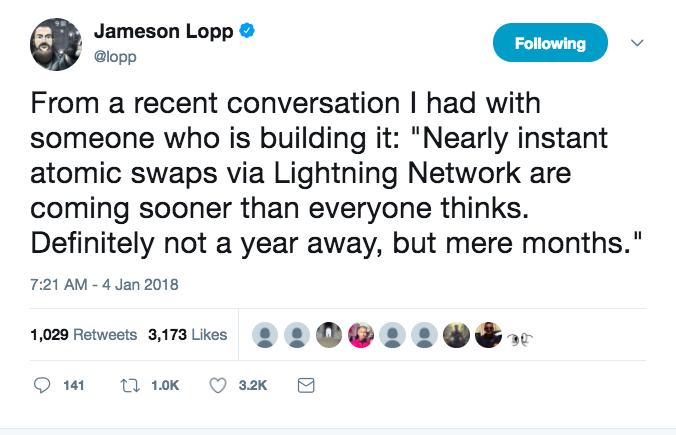
Final Thoughts
Whether anything comes of the Twitter exchange between Lee and Spagni is anyone’s guess, but it did bring up a number of important issues. Not the least of which is what would a partnership look like in the context of two decentralized open-source blockchains?
If Litecoin and Monero do ultimately move forward in any tangible way, they may provide us with an A-list example. In the future, it’s likely that all cryptocurrencies will have the ability to swap with one another on-chain. This means no more fees, no more exchange hacks and less phishing scams. But the technology still needs to evolve to make this into a reality, and in the near-term, such a feature requires close collaboration between devs and a lot of work.
If you’d like to survey the atomic swap landscape, a site has been built that shows each crypto’s readiness.
The bottom line here is that this type of news should be of interest for not only fans of Litecoin/Monero and price speculators, but anyone who’s keen on the advancement of blockchain technology as a whole.
To use the words of Bitcoin developer Alex Bosworth: “The atomic age is coming, what cannot be swapped will be left behind.”

